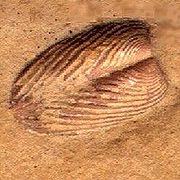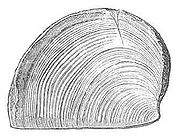
Aptychus
Encyclopedia


Fossil
Fossils are the preserved remains or traces of animals , plants, and other organisms from the remote past...
, a hard anatomical structure like a curved shelly plate, which was part of the body of an ammonite
Ammonite
Ammonite, as a zoological or paleontological term, refers to any member of the Ammonoidea an extinct subclass within the Molluscan class Cephalopoda which are more closely related to living coleoids Ammonite, as a zoological or paleontological term, refers to any member of the Ammonoidea an extinct...
. Paired aptychi have, on rare occasions, been found at or within the aperture
Aperture (mollusc)
The aperture is an opening in certain kinds of mollusc shells: it is the main opening of the shell, where part of the body of the animal emerges for locomotion, feeding, etc....
of ammonite shells.
Aptychi are often found well-preserved as fossil
Fossil
Fossils are the preserved remains or traces of animals , plants, and other organisms from the remote past...
s, but are only very rarely found connected to ammonite shells. This circumstance led to them being initially classified as the valves of bivalves, which they somewhat resemble. Aptychi are found in rocks from the Devonian period through to the those of the Cretaceous period. The aptychus was usually composed of calcite
Calcite
Calcite is a carbonate mineral and the most stable polymorph of calcium carbonate . The other polymorphs are the minerals aragonite and vaterite. Aragonite will change to calcite at 380-470°C, and vaterite is even less stable.-Properties:...
, whereas the ammonite shell was aragonite
Aragonite
Aragonite is a carbonate mineral, one of the two common, naturally occurring, crystal forms of calcium carbonate, CaCO3...
.
There are many forms of aptychus, varying in shape and in the sculpture of the inner and outer surfaces. However, because they are so rarely found in position within the ammonite shell, it is often unclear as to which species of ammonite many aptychi belong.
When only a single plate is present, as is sometimes the case, the term "anaptycus" is used.
Function
Aptychi seem to have most often existed as bilaterally-symmetrical pairs, and were first described (incorrectly) as being the valves of bivalve mollusks. Aptychi are now considered to be either: (1) a two-valved closing hatch on the shells of extinct ammoniteAmmonite
Ammonite, as a zoological or paleontological term, refers to any member of the Ammonoidea an extinct subclass within the Molluscan class Cephalopoda which are more closely related to living coleoids Ammonite, as a zoological or paleontological term, refers to any member of the Ammonoidea an extinct...
s; or (2) a double-plate jaw-piece similar to that of some modern cephalopod
Cephalopod
A cephalopod is any member of the molluscan class Cephalopoda . These exclusively marine animals are characterized by bilateral body symmetry, a prominent head, and a set of arms or tentacles modified from the primitive molluscan foot...
s.
Set close to or against the shell's terminal opening (the living chamber), the aptychi usually consisted of two identical but mirror image
Mirror image
A mirror image is a reflected duplication of an object that appears identical but reversed. As an optical effect it results from reflection off of substances such as a mirror or water. It is also a concept in geometry and can be used as a conceptualization process for 3-D structures...
valves. Some authors consider the aptychus to be a jaw apparatus (mandibles), while others believe them to be paired opercula
Operculum (animal)
An operculum is an anatomical feature, a stiff structure resembling a lid or a small door that opens and closes, and thus controls contact between the outside world and an internal part of an animal...
. If the latter is the case, then aptychi may have had a function similar to the head shield of modern nautilus
Nautilus
Nautilus is the common name of marine creatures of cephalopod family Nautilidae, the sole extant family of the superfamily Nautilaceae and of its smaller but near equal suborder, Nautilina. It comprises six living species in two genera, the type of which is the genus Nautilus...
es.

